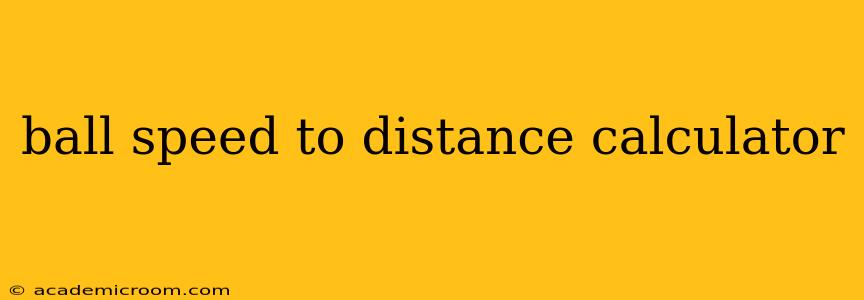For golfers of all levels, understanding the relationship between ball speed and distance is crucial for improving their game. Knowing how far your ball travels based on your swing speed empowers you to fine-tune your technique, select the right clubs, and ultimately, lower your scores. While a dedicated ball speed to distance calculator can provide precise figures, this article will delve into the factors influencing this relationship, providing you with a deeper understanding beyond just the numbers.
What is a Ball Speed to Distance Calculator?
A ball speed to distance calculator is a tool, often found online or within golf apps, that estimates the distance a golf ball will travel based on its initial speed off the clubface. These calculators utilize complex formulas that take into account various factors, as we'll explore below, to provide a reasonable projection. Keep in mind that these are estimations; actual distance will vary based on several real-world variables.
Factors Affecting Ball Speed to Distance
Several elements influence how far your ball will fly, even with the same clubhead speed. Understanding these helps you interpret the calculator's output and improve your game.
1. Launch Angle: The Upward Trajectory
The angle at which the ball leaves the clubface significantly impacts distance. Too low a launch angle will result in a low, rolling shot, while too high will lead to a balloon-like trajectory that loses distance quickly. Optimal launch angles vary depending on club and golfer, generally falling within a range of 10-15 degrees for drivers. A ball speed to distance calculator often incorporates launch angle as a key variable.
2. Spin Rate: The Twist and Turn
Backspin is crucial for maximizing distance. Sufficient backspin helps the ball stay airborne longer, allowing gravity to work less aggressively against its flight. However, excessive spin can lead to a shorter distance due to increased drag. A well-struck shot usually has a balance of backspin to keep the ball aloft but not impede its progress.
3. Carry vs. Total Distance: Understanding the Difference
Ball speed to distance calculators often provide both carry distance (the distance the ball travels in the air before landing) and total distance (carry plus roll). The roll of the ball after landing, particularly on fairways, can add substantial yards to your overall distance. This roll is influenced by the ball's spin rate and the firmness of the ground.
4. Club Head Speed: The Foundation of Distance
This is the most straightforward factor. Faster clubhead speed generally translates to higher ball speed and greater distance. Improving your swing mechanics to generate more clubhead speed is a primary goal for most golfers striving to increase distance.
5. Ball Type and Conditions: Subtle but Significant Impacts
The type of golf ball you use plays a role. Different balls have varying levels of compression and spin characteristics, subtly influencing your distance. Likewise, environmental conditions like wind speed and direction, temperature, and altitude all impact your shot's trajectory and final distance.
How Accurate Are Ball Speed to Distance Calculators?
While these calculators provide useful estimates, it's crucial to remember that they're not perfect. Real-world conditions introduce variability that a calculator can't fully account for. They should be used as a guideline to understand the general relationship between ball speed and distance, rather than a precise predictor of every shot.
What other factors affect golf ball distance?
Besides the factors already discussed, other elements influence your golf ball's distance. These include:
- Club Selection: Different clubs are designed for different distances, so choosing the right club is vital.
- Swing Mechanics: A well-executed swing will consistently achieve better results than an inconsistent one, regardless of ball speed.
- Physical Fitness: Strength and flexibility contribute to a powerful swing, which directly impacts ball speed.
Can I improve my golf ball distance?
Absolutely! Consistent improvement in golf ball distance is achievable through focused practice and training. Work on these key areas:
- Improve your swing mechanics: Professional lessons can help identify and correct flaws.
- Increase your clubhead speed: Strength training and swing drills can boost your speed.
- Optimize your launch angle and spin rate: Use launch monitors to track your progress.
By understanding the factors influencing ball speed and distance, you can use a calculator more effectively and, more importantly, focus your practice to improve your game. Remember to always combine these tools with on-course experience to develop a keen understanding of your individual capabilities.
